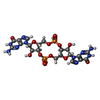+ データを開く
データを開く
- 基本情報
基本情報
| 登録情報 | データベース: PDB / ID: 9lmq | ||||||
|---|---|---|---|---|---|---|---|
| タイトル | Cryo-EM structure of TIR-STING/c-di-GMP complex | ||||||
 要素 要素 | CD-NTase-associated protein 12 | ||||||
 キーワード キーワード | HYDROLASE / NADase | ||||||
| 機能・相同性 |  機能・相同性情報 機能・相同性情報NAD+ glycohydrolase / NADP+ nucleosidase activity / defense response to virus / nucleotide binding 類似検索 - 分子機能 | ||||||
| 生物種 |  Epilithonimonas lactis (バクテリア) Epilithonimonas lactis (バクテリア) | ||||||
| 手法 | 電子顕微鏡法 / 単粒子再構成法 / クライオ電子顕微鏡法 / 解像度: 2.88 Å | ||||||
 データ登録者 データ登録者 | Lu, D.F. / Liu, S. | ||||||
| 資金援助 |  中国, 1件 中国, 1件
| ||||||
 引用 引用 |  ジャーナル: mBio / 年: 2025 ジャーナル: mBio / 年: 2025タイトル: Structural insights into distinct filamentation states reveal a regulatory mechanism for bacterial STING activation. 著者: Yuchao Yang / Yueyue Liu / Xue Ma / Xuan Zhao / Jian Cao / Yu Liu / Shanqin Li / Jing Wu / Yuanzhu Gao / Lianwan Chen / Changxin Wu / Guijun Shang / Sheng Liu / Defen Lu /  要旨: The cyclic oligonucleotide-based antiphage signaling system (CBASS) is a bacterial immune mechanism that was evolutionarily linked to the eukaryotic cGAS-STING pathway, which protects against phage ...The cyclic oligonucleotide-based antiphage signaling system (CBASS) is a bacterial immune mechanism that was evolutionarily linked to the eukaryotic cGAS-STING pathway, which protects against phage infection through abortive cell death. CBASS operons encode cyclic dinucleotide synthases (CD-NTases) and effector proteins (Caps), such as bacterial STING, which senses cyclic dinucleotides like 3'3'-c-di-GMP to trigger defense. Although bacterial STING oligomerizes into filaments upon ligand binding, the functional roles of distinct filament states remain unclear. Here, we resolve cryo-EM structures of TIR-STING (STING) bound to 3'3'-c-di-GMP, revealing two oligomeric states: spiral-shaped single filaments and fiber bundles composed of straight protofibrils. In spiral filaments, the STING domain sequesters the TIR domain's BB loop within a hydrophobic core, suppressing NADase activity. This inactive conformation is stabilized by interactions between the CBDα4 helix and the TIR domain, as well as a calcium-binding site. Conversely, fiber bundle formation-driven by inter-protofibril TIR domain interactions-disrupts these autoinhibitory contacts, liberating the BB loop to enable head-to-tail assembly of adjacent TIR domains into a composite NADase-active site. Calcium ions promote spiral filament assembly while inhibiting fiber bundles, revealing a dual regulatory role in tuning STING activation. Strikingly, this mechanism diverges from single-filament systems like STING, underscoring evolutionary diversity in STING signaling. Our findings establish distinct filament architectures as structural checkpoints governing bacterial STING activation, providing mechanistic insights into how conformational plasticity and environmental cues like calcium regulate abortive infection. These results highlight parallels between prokaryotic and eukaryotic immune strategies, emphasizing conserved principles in pathogen defense across domains of life.IMPORTANCEBacteria employ a sophisticated immune system, CBASS, evolutionarily related to human antiviral pathways, to defend against viral (phage) attacks. This study reveals how the bacterial protein STING acts as a molecular switch, transitioning between an inactive spiral structure stabilized by calcium ions and an active fiber bundle. When calcium levels drop, STING reorganizes into fiber bundles, activating its ability to degrade essential cellular molecules. This self-destructive mechanism halts phage replication by sacrificing the infected cell, protecting the bacterial population. The findings demonstrate how structural rearrangements govern life-or-death immune decisions, mirroring principles in human STING signaling. By uncovering calcium's role in regulating this process, the work deepens our understanding of microbial immunity and highlights shared strategies across domains of life. These insights could inspire novel antimicrobial therapies or bioengineered systems to combat infections, bridging fundamental science with practical applications in health and biotechnology. | ||||||
| 履歴 |
|
- 構造の表示
構造の表示
| 構造ビューア | 分子:  Molmil Molmil Jmol/JSmol Jmol/JSmol |
|---|
- ダウンロードとリンク
ダウンロードとリンク
- ダウンロード
ダウンロード
| PDBx/mmCIF形式 |  9lmq.cif.gz 9lmq.cif.gz | 432.4 KB | 表示 |  PDBx/mmCIF形式 PDBx/mmCIF形式 |
|---|---|---|---|---|
| PDB形式 |  pdb9lmq.ent.gz pdb9lmq.ent.gz | 360.6 KB | 表示 |  PDB形式 PDB形式 |
| PDBx/mmJSON形式 |  9lmq.json.gz 9lmq.json.gz | ツリー表示 |  PDBx/mmJSON形式 PDBx/mmJSON形式 | |
| その他 |  その他のダウンロード その他のダウンロード |
-検証レポート
| 文書・要旨 |  9lmq_validation.pdf.gz 9lmq_validation.pdf.gz | 1.5 MB | 表示 |  wwPDB検証レポート wwPDB検証レポート |
|---|---|---|---|---|
| 文書・詳細版 |  9lmq_full_validation.pdf.gz 9lmq_full_validation.pdf.gz | 1.5 MB | 表示 | |
| XML形式データ |  9lmq_validation.xml.gz 9lmq_validation.xml.gz | 75.4 KB | 表示 | |
| CIF形式データ |  9lmq_validation.cif.gz 9lmq_validation.cif.gz | 110.7 KB | 表示 | |
| アーカイブディレクトリ |  https://data.pdbj.org/pub/pdb/validation_reports/lm/9lmq https://data.pdbj.org/pub/pdb/validation_reports/lm/9lmq ftp://data.pdbj.org/pub/pdb/validation_reports/lm/9lmq ftp://data.pdbj.org/pub/pdb/validation_reports/lm/9lmq | HTTPS FTP |
-関連構造データ
| 関連構造データ |  63221MC  9lmrC M: このデータのモデリングに利用したマップデータ C: 同じ文献を引用 ( |
|---|---|
| 類似構造データ | 類似検索 - 機能・相同性  F&H 検索 F&H 検索 |
- リンク
リンク
- 集合体
集合体
| 登録構造単位 | 
|
|---|---|
| 1 |
|
- 要素
要素
| #1: タンパク質 | 分子量: 35717.707 Da / 分子数: 8 / 由来タイプ: 組換発現 由来: (組換発現)  Epilithonimonas lactis (バクテリア) Epilithonimonas lactis (バクテリア)遺伝子: IO89_10965 / 発現宿主:  #2: 化合物 | ChemComp-C2E / #3: 化合物 | ChemComp-CA / #4: 水 | ChemComp-HOH / | 研究の焦点であるリガンドがあるか | Y | Has protein modification | N | |
|---|
-実験情報
-実験
| 実験 | 手法: 電子顕微鏡法 |
|---|---|
| EM実験 | 試料の集合状態: PARTICLE / 3次元再構成法: 単粒子再構成法 |
- 試料調製
試料調製
| 構成要素 | 名称: TIR-STING/c-di-GMP complex / タイプ: COMPLEX / Entity ID: #1 / 由来: RECOMBINANT |
|---|---|
| 由来(天然) | 生物種:  Epilithonimonas lactis (バクテリア) Epilithonimonas lactis (バクテリア) |
| 由来(組換発現) | 生物種:  |
| 緩衝液 | pH: 8 |
| 試料 | 包埋: NO / シャドウイング: NO / 染色: NO / 凍結: YES |
| 急速凍結 | 凍結剤: ETHANE |
- 電子顕微鏡撮影
電子顕微鏡撮影
| 実験機器 |  モデル: Titan Krios / 画像提供: FEI Company |
|---|---|
| 顕微鏡 | モデル: TFS KRIOS |
| 電子銃 | 電子線源:  FIELD EMISSION GUN / 加速電圧: 300 kV / 照射モード: FLOOD BEAM FIELD EMISSION GUN / 加速電圧: 300 kV / 照射モード: FLOOD BEAM |
| 電子レンズ | モード: BRIGHT FIELD / 最大 デフォーカス(公称値): 2000 nm / 最小 デフォーカス(公称値): 1000 nm |
| 撮影 | 電子線照射量: 50 e/Å2 フィルム・検出器のモデル: GATAN K2 QUANTUM (4k x 4k) |
- 解析
解析
| EMソフトウェア | 名称: PHENIX / バージョン: 1.19.2_4158 / カテゴリ: モデル精密化 | ||||||||||||||||||||||||
|---|---|---|---|---|---|---|---|---|---|---|---|---|---|---|---|---|---|---|---|---|---|---|---|---|---|
| CTF補正 | タイプ: PHASE FLIPPING AND AMPLITUDE CORRECTION | ||||||||||||||||||||||||
| 3次元再構成 | 解像度: 2.88 Å / 解像度の算出法: FSC 0.143 CUT-OFF / 粒子像の数: 523122 / 対称性のタイプ: POINT | ||||||||||||||||||||||||
| 精密化 | 最高解像度: 2.88 Å 立体化学のターゲット値: REAL-SPACE (WEIGHTED MAP SUM AT ATOM CENTERS) | ||||||||||||||||||||||||
| 拘束条件 |
|
 ムービー
ムービー コントローラー
コントローラー




 PDBj
PDBj





